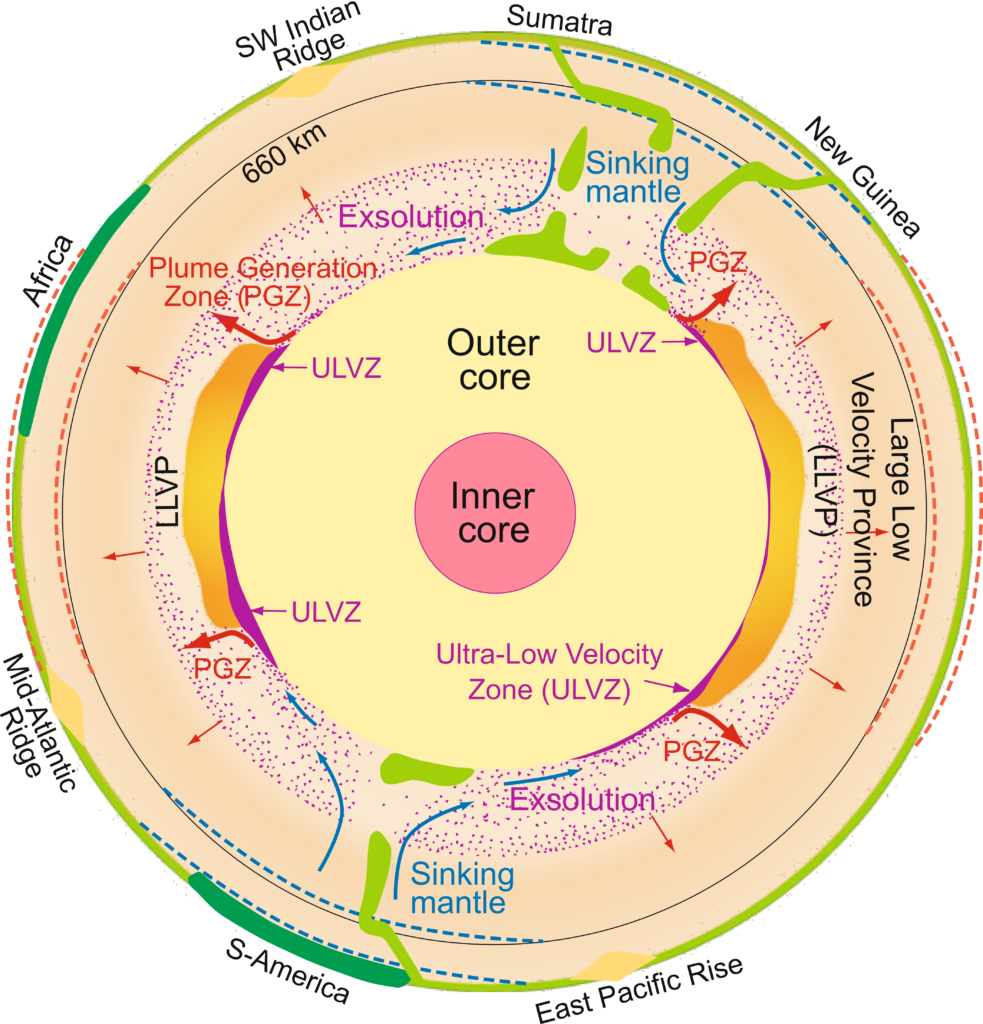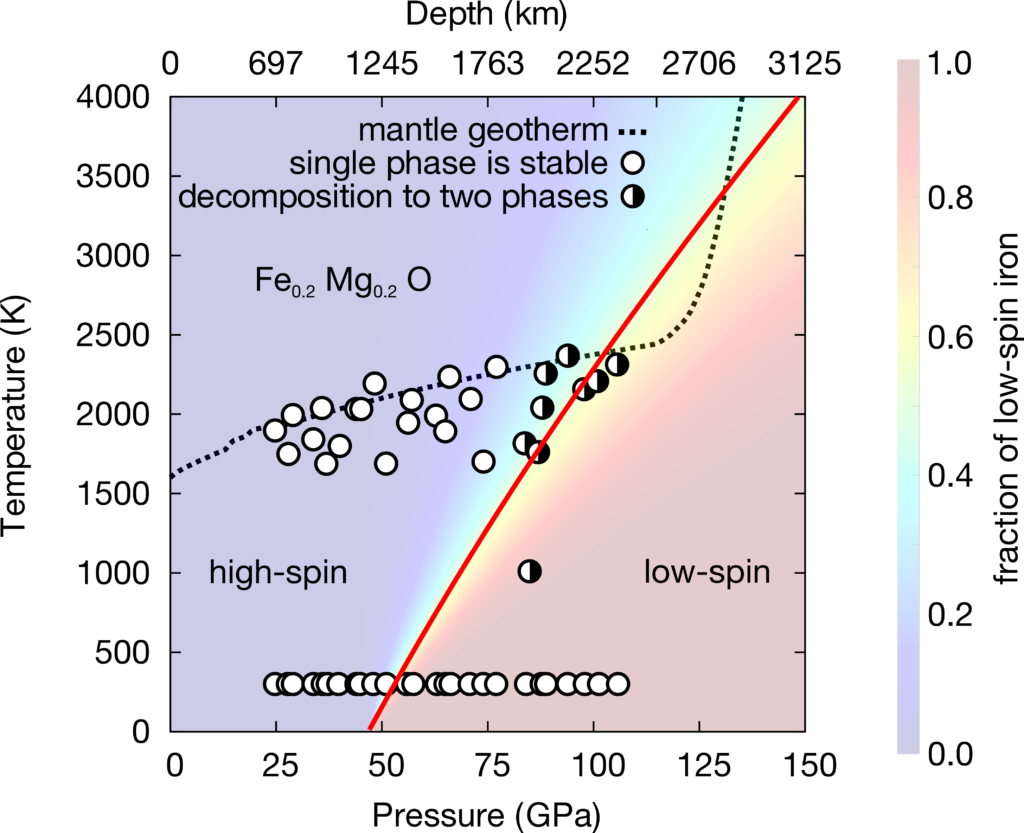The Spin Deep Within: Physics of Ferropericlase in the Earth’s Lower Mantle
The Spin Deep Within: Physics of Ferropericlase in the Earth’s Lower Mantle
Stephen Stackhouse (s.stackhouse@leeds.ac.uk)
Andy Nowacki (a.nowacki@leeds.ac.uk)
1. Introduction
Even though we live on the surface of the Earth, its mantle in many ways remains a mystery. In particular, there are some fundamental properties of the rocks that comprise the mantle, thousands of kilometers beneath our feet, which remain poorly understood. This is one of the biggest barriers to better understanding the history and future of the Earth as a whole. The reason for this is that the principle technique we have for understanding what is inside the Earth is seismology, which uses knowledge of the physical properties of mantle minerals to convert the wave speeds inferred from seismic studies into a physical model of the mantle. In this research project, you will attempt to solve some of the key open questions regarding the mineral physics of the mantle—the effect of electronic spin state and exsolution on the properties of the mantle mineral ferropericlase.
Seismologists map out the behaviour of different kinds of seismic waves (e.g. their speed) that travel through different parts of the Earth’s interior after large earthquakes. Using specialized computer algorithms, they are able to produce a three-dimensional model of structures inside the Earth (Figure 1). To interpret these structures, mineral physicists determine how material with a mantle composition changes at lower mantle pressures and temperatures, e.g. what the stable mineral phases are and their elastic properties. As the behaviour of seismic waves depends on the elastic properties of the material that they pass through, it is then possible to relate different regions of the mantle to particular mineral compositions and dynamic processes.

Figure 1. Schematic cross-section of Earth’s interior. Large-low-velocity-provinces (LLVP) are observed under southern Africa and the central Pacific, exhibiting lower than average seismic velocities, Ultra-low-velocity-zones (ULVZs) are found at the edges of LLVPs, situated directly below plume generation zones (PGZs). Upwellings from PGZs (indicated by red arrows) lead to continental uplift, resulting in geoid highs (indicated by the dashed red lines). At the same time, cold slabs (shown as green blobs) sink into the mantle, stagnating at the 660 km discontinuity. Purple stippling indicates the potential exsolution of ferropericlase, which may have occurred closer to the core in the early Earth when the iron-content of ferropericlase was higher. Figure adapted from (Trønnes, 2010)
2. Spin Transition and Exsolution
This research project focuses on two process expected to occur in the mineral ferropericlase (FexMg(1-x)O), the second most abundant phase in the lower mantle: an electronic spin transition (e.g.Badro et al., 2003; Lin et al., 2005) and exsolution (e.g. Dubrovinsky et al., 2000). The spin transition is the pairing of the d-electrons of iron in ferropericlase, as it is compressed, with depth in the lower mantle. This is observed in high-pressure experiments (e.g. Marquardt et al., 2009) and calculations (e.g. Wentzcovitch et al., 2009) and leads to a density increase, as the volume of iron ions rapidly decrease. However, there are presently significant differences in the results of studies predicting the conditions at which the spin transition occurs and also between mineral physics models and seismic observations. Consequently, interpretations in terms of dynamic processes in the mantle currently remain unreliable. We have recently made some progress in understanding these differences (Méndez et al., 2022; Trautner et al., 2023), but much work remains. Exsolution of ferropericlase is the process, where it separates into Mg-rich and Fe-rich phases, which has also been reported in high-pressure experiments. Exsolution appears to occur at the same conditions as the spin transition (Figure 2) and the processes could be linked, with magnetic entropy playing a role (Li and Stackhouse, 2020). This could be an explanation for the discrepancy between current mineral physics models and seismic observations. However, the effect of exsolution has never been studied.

Figure 2. Phase stability of Fe0.2Mg0.8O. Solid white circles indicate conditions at which single-phase Fe0.2Mg0.8O is observed to be stable, while half-filled circles denote conditions at which a mixture of Mg-rich and Fe-rich phases are observed (Dubrovinsky et al., 2005). Colourmap shows the fraction of low-spin iron for Fe0.1875Mg0.8125O (preliminary results). The solid red line marks the mid-point of the spin transition, where the fraction of low-spin iron is equal to 0.5. The dashed black line is a mantle geotherm. Exsolution appears to occur at similar conditions to the spin transition and the two could be related.
It is important to be able to map out the spin state of iron in ferropericlase, as it influences the dynamics of the mantle (Bower et al., 2009), e.g. how fast hot material rises and cold material sinks. This ultimately provides the driving forces for surface processes such as plate tectonics, as well as deep mantle processes that impact on core dynamics and magnetic field generation (Figure 1). It does this in several ways. The spin transition changes the (radiative) thermal conductivity and viscosity of ferropericlase, which impacts mantle flow. In addition, the increase/decrease in the density of ferropericlase passing through the spin transition, as it sink/rises in the mantle, leads to a decrease/increase in buoyancy. Exsolution is also important, due to its role in controlling spin state, as the spin transition pressure increases with iron-content.
3. Theoretical Methods
In this project theoretical calculation will be performed to constrain the depth and breadth of the spin transition and exsolution reaction in ferropericlase, as a function of iron-content, using the Vienna Ab Initio Simulation Package (VASP). These will allow investigation of how the spin transition is influenced by composition and the arrangement of iron (i.e. whether all the iron atoms are close together in a cluster or evenly spread out). This latter has been previously reported to influence the spin transition (Kantor et al., 2009) and our preliminary calculations show that the arrangement of iron is important. Your research will be carried out in collaboration with the group of Dr Hauke Marquardt at the Department of Earth Sciences, at the University of Oxford, who will be carrying out parallel experimental investigations.
4. Proposed Research
The overall aim of this project is to develop an accurate mineral physics model of the spin transition in ferropericlase, taking into account exsolution, and use it to help interpret seismic observations of the lower mantle. In particular, you will:
- Constrain the depth and breadth of the spin transition in ferropericlase and its compositional dependence, including the influence of cation ordering.
- Constrain the depth and breadth of exsolution reaction in ferropericlase and its compositional dependence.
- Determine the elastic properties of ferropericlase as a function of spin state temperature, pressure, and composition.
- Predict the influence of the spin transition and exsolution in ferropericlase on seismic velocities and compare them with seismic observations.
5. Potential for High Impact Outcome
The results will provide a constrained set of parameters that can be used for thermodynamic modeling, modeling of mantle dynamics, and mapping of lower mantle processes, to provide more accurate models of past and present-day mantle structure and dynamics.
6. Training
You will be trained in the application of atomistic simulations and high performance computing. In particular, you will be taught to perform density functional theory calculations, a method that is used widely in chemistry, physics, and materials science research. Alongside the transferable skills in communication and management this can open a range of career pathways. These skills will be developed by a mixture of hands on experience, attending external training courses and taking part in the Panorama NERC Doctoral Training Partnership Programme. You will become a member of the University of Leeds Deep Earth Research Group, benefiting from interactions with other staff and students who have a range of interests and expertise.
7. Student Profile
You will have a good first degree in the physical sciences (e.g. physics, chemistry, geophysics or related subject). The ideal candidate will also have experience of basic scientific programming and computation possibly derived from the completion of an undergraduate research project in the area. Experience performing atomistic simulations would be an advantage.
